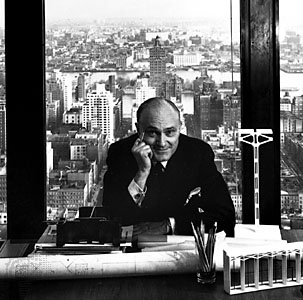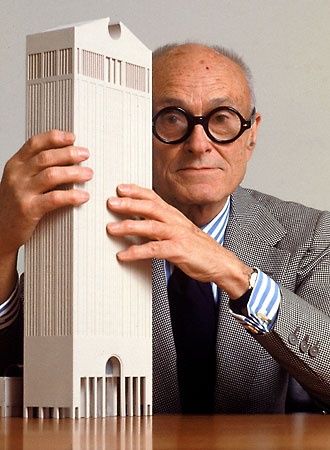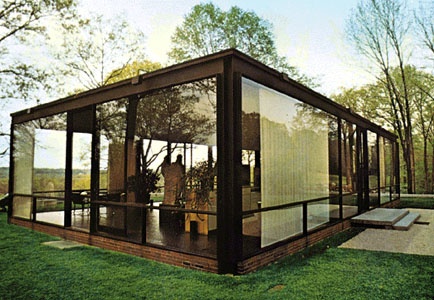Johnson, Philip C.
American architect
in full Philip Cortelyou Johnson
born July 8, 1906, Cleveland, Ohio, U.S.
died Jan. 25, 2005, New Canaan, Conn.

 American architect and critic known both for his promotion of the International Style and, later, for his role in defining postmodernist architecture.
American architect and critic known both for his promotion of the International Style and, later, for his role in defining postmodernist architecture. Johnson majored in philosophy at Harvard University, graduating in 1927. In 1932 he was named director of the Department of Architecture of the Museum of Modern Art (Modern Art, Museum of) (MoMA) in New York. With Henry-Russell Hitchcock he wrote The International Style: Architecture Since 1922 (1932), which provided a description of (and also a label for) post-World War I modern architecture. In 1940 Johnson returned to Harvard (B.Arch., 1943), where he studied architecture with Marcel Breuer (Breuer, Marcel). His real mentor, however, was Ludwig Mies van der Rohe (Mies van der Rohe, Ludwig), with whom he worked on the widely praised Seagram Building in New York City (1958). After World War II Johnson returned to MoMA as director of the architecture department from 1946 to 1954. His influential monograph Mies van der Rohe was published in 1947 (rev. ed., 1953).
Johnson majored in philosophy at Harvard University, graduating in 1927. In 1932 he was named director of the Department of Architecture of the Museum of Modern Art (Modern Art, Museum of) (MoMA) in New York. With Henry-Russell Hitchcock he wrote The International Style: Architecture Since 1922 (1932), which provided a description of (and also a label for) post-World War I modern architecture. In 1940 Johnson returned to Harvard (B.Arch., 1943), where he studied architecture with Marcel Breuer (Breuer, Marcel). His real mentor, however, was Ludwig Mies van der Rohe (Mies van der Rohe, Ludwig), with whom he worked on the widely praised Seagram Building in New York City (1958). After World War II Johnson returned to MoMA as director of the architecture department from 1946 to 1954. His influential monograph Mies van der Rohe was published in 1947 (rev. ed., 1953).
 Johnson's reputation was enlarged by the design of his own residence, known as the Glass House, at New Canaan, Conn. (1949). The house, which is notable for its severely simple rectilinear structure and its use of large glass panels as walls, owed much to the precise, minimalist aesthetic of Mies but also alluded to the work of 18th- and 19th-century architects. (In addition to the Glass House, Johnson's New Canaan estate featured a number of other structures, including an art gallery and a sculpture pavilion. He later donated the estate to the National Trust for Historic Preservation, and in 2007 it was opened to the public.) This balance between Miesian influence and historical allusion shifted in the 1950s. Beginning with the Temple Kneses Tifereth Israel in Port Chester, N.Y. (1956), Johnson made fuller use of curvilinear (particularly arch) forms and historical quotation, a pattern continued in the art gallery at Dumbarton Oaks in Washington, D.C. (1963), and the IDS Center, a multibuilding group in Minneapolis (1973).
Johnson's reputation was enlarged by the design of his own residence, known as the Glass House, at New Canaan, Conn. (1949). The house, which is notable for its severely simple rectilinear structure and its use of large glass panels as walls, owed much to the precise, minimalist aesthetic of Mies but also alluded to the work of 18th- and 19th-century architects. (In addition to the Glass House, Johnson's New Canaan estate featured a number of other structures, including an art gallery and a sculpture pavilion. He later donated the estate to the National Trust for Historic Preservation, and in 2007 it was opened to the public.) This balance between Miesian influence and historical allusion shifted in the 1950s. Beginning with the Temple Kneses Tifereth Israel in Port Chester, N.Y. (1956), Johnson made fuller use of curvilinear (particularly arch) forms and historical quotation, a pattern continued in the art gallery at Dumbarton Oaks in Washington, D.C. (1963), and the IDS Center, a multibuilding group in Minneapolis (1973).Johnson's style took a final turn with the New York City American Telephone and Telegraph headquarters (1984; now the Sony building). Designed with a top resembling a Chippendale cabinet, the building was considered by critics to be a landmark in the history of postmodern architecture. Johnson turned explicitly to the 18th century for his design of the Gerald D. Hines College of Architecture at the University of Houston (1983–85); it was based on unexecuted plans published by the French architect Claude-Nicolas Ledoux (Ledoux, Claude-Nicolas). Johnson's partner in these endeavours (1967–91) was the architect John Henry Burgee.
Johnson, who continued to design into the early 21st century, received a number of awards, including the American Institute of Architects Gold Medal (1978) and the first Pritzker Architecture Prize (1979).
- Midland
- Midland Bank PLC
- Midlands
- Midlothian
- Midnapore
- midnight Sun
- Mid Suffolk
- Midsummer Night's Dream, A
- Midsummer's Eve
- Mid Sussex
- Midway, Battle of
- Midway Islands
- Midwest City
- Midwestern Regionalism
- midwifery
- midwife toad
- Mie
- Mieczysława Ćwiklińska
- Mieczysław Jastrun
- Mieczysław Moczar
- Mielziner, Jo
- Mien
- Miercurea-Ciuc
- Mieres
- Mierevelt, Michiel Janszoon van